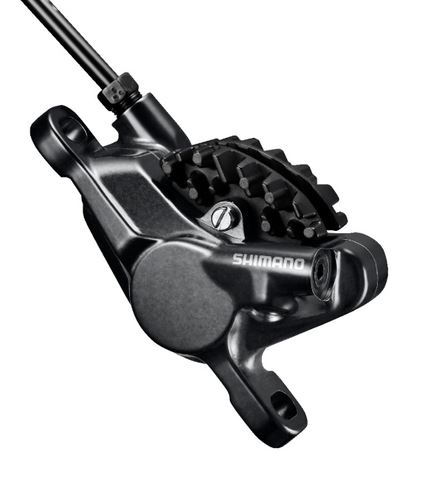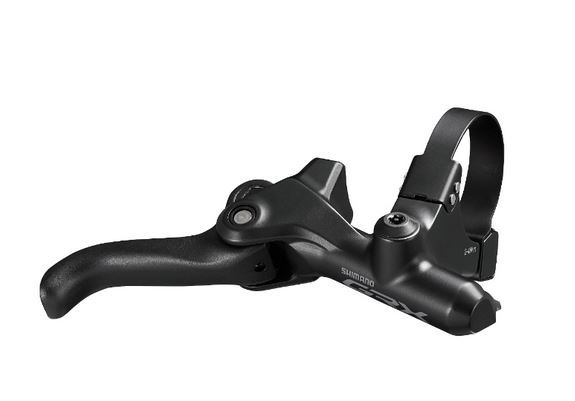I just went through the process of putting Shimano road hydraulic brakes on our 12-year-old Co-Motion Speedster tandem and learned a few things that I thought others could benefit from:
Not many tandem forks or frames use the newer road-style "flat-mount" brakes, which is probably not a bad thing because flat-mount only allows up to 160mm rotors, and most tandem riders will choose larger rotors than that. Post-mount or IS mount disc brakes is the norm for tandems and although post-mount to flat-mount adapters do exist, they are not common and might not work in all cases.
Fortunately, although when sold in a lever-brake kit, current generation Shimano road hydraulic disc brakes only come with flat mount brakes, Shimano sells the levers separately and still sells the previous-generation RS785 road disc brakes that use post-mount fittings. Just be careful not to get the really early version of the RS785 that had the "banjo" hose fitting on the side, get the newer RS785 where the hose plugs directly into the caliper (shown below). Shimano's current compatibility table lists the RS785 as being fully compatible with the newest generation of road hydraulic levers (i.e., 7000 series 105, 8000 series Ultegra, 9100 series DA) because Shimano knows that there are still road disc bikes that don't have flat-mounts.

To connect the newer levers to the RS785 brakes, you need the BH90 hose, and if you buy the "SSR" version of the hose kit then you get all of the correct connectors. However, the SSR kit only comes in 1.0 or 1.7 meter lengths, which is a problem for the rear brake on a tandem. Shimano doesn't care because they've officially stated that their hydraulic disc brakes are not rated for tandem use (but what else are we supposed to use?). After some searching, I found the "SS" version of the BH90 hose kit is available in a 2.0 meter length, which is the same hose but not the right connectors, so I ordered the 2.0m SS kit plus an extra 1.0m SSR kit so I'd have the connectors (maybe you can buy the connectors separately, but the extra SSR kit wasn't very expensive and maybe I'll need that extra hose one day). Some bike shops may have the bulk roll of BH90 housing and you could then buy the length you need, but even in the high-end shop that I used to work in the boss refused to buy that bulk roll when a customer asked because he couldn't imagine ever being able to sell the rest of it.
But, 2.0m is still a bit too short for the rear brake on a tandem! No problem, because Shimano now sells hydraulic interruptor brake levers in the GRX series (model BL-RX812) that mount next to the stem (shown below). These allow you to brake when holding the bar tops, which is quite useful when riding and great for holding the bike steady when stopping briefly. The interruptor levers are also really handy hose connectors and are again officially compatible with all the current road hydraulic levers (not only the GRX versions). The 2.0m hose is long enough to reach from the rear brake to the GRX lever (I had to trim it by about 10 cm on our small-size tandem) and then the GRX lever comes with a short section of BH90 hose and all the connectors to go between the extra lever and the regular brake lever - just be careful when trimming that down because it needs to be close to the perfect length to hide neatly under the bar tape.

These parts are delivered with no hydraulic fluid inside, so the next complication is filling the system with fluid and getting all of the air bubbles out, which isn't simple, especially with the extra lever also needing to be air-free. If you don't have the proper syringes, funnels, adapters, and a bit of experience then I'd recommend getting a professional to do it. To do it yourself properly, download
Shimano's dealer manual and follow the instructions starting on page 70 and especially the part starting on page 75 for the extra steps with the interruptor lever. I've now setup a total of 4 brakes with the interruptor levers and on half of them I've been successful the first time, the other half I've immediately had to do a second bleeding of the fluid because there was too much air in the system. After getting each of them bled properly at the beginning, everything has continued to work well since.
I only installed a right-hand interruptor lever because that's all we had when we had mechanical brakes. I mainly just use that lever for holding the bike steady when stopped and we already have the Di2 gear display (SC-M9051) on the left side of the stem which would need to be moved if we had another lever there, but you may prefer to have a pair if you plan to use these levers much when actually riding.
We've gone with 180mm rotors front and rear and changed the stock resin brake pads to Shimano's metal pads and so far we are very happy with the performance.
If you want advice about installing non-Shimano hydraulic brakes then you'll have to ask someone else. I've been a professional bike mechanic for 8 years and based on my experience, I'll never touch any hydraulic brakes other than Shimano when I have the choice - Shimano are the only hydraulic brakes that I can bleed reliably, change brake pads easily, and I also hate the idea of using corrosive DOT fluid. Also, Shimano offers far more versions and accessories for all of their products than other brands do, which is what allowed all of this to go together so flawlessly for us.